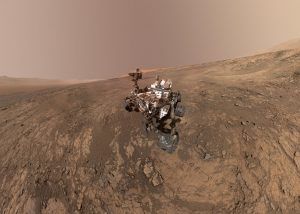Eric Betz in Discover:
 In a much-hyped press conference held on Thursday, NASA announced its Curiosity rover had uncovered new evidence of methane — a potential sign of life — as well as signs of organic compounds buried in ancient mudstone. The space agency did not say it had found evidence of alien life. However, these new results are still tantalizing. Curiosity landed on Mars back in 2012 and it’s been slowly climbing up Mount Sharp, a large hill formed when an asteroid impact created Gale Crater, simultaneously exposing multi-billion year old sedimentary rocks laid down in an ancient lakebed. The rover came equipped with a suite of instruments known as Sample Analysis at Mars, or SAM. And its main goal was to find organic molecules. These commonly form in non-biological processes, but they’re also the building blocks of life. And mysteriously, the VW Beetle-sized rover succeeded in finding organics even though past Mars missions, like 1976’s Viking landers, did not. This latest announcement was tied to two scientific papers published simultaneously in the prestigious journal Science. One study focused on the methane and the other looked at the organics.
In a much-hyped press conference held on Thursday, NASA announced its Curiosity rover had uncovered new evidence of methane — a potential sign of life — as well as signs of organic compounds buried in ancient mudstone. The space agency did not say it had found evidence of alien life. However, these new results are still tantalizing. Curiosity landed on Mars back in 2012 and it’s been slowly climbing up Mount Sharp, a large hill formed when an asteroid impact created Gale Crater, simultaneously exposing multi-billion year old sedimentary rocks laid down in an ancient lakebed. The rover came equipped with a suite of instruments known as Sample Analysis at Mars, or SAM. And its main goal was to find organic molecules. These commonly form in non-biological processes, but they’re also the building blocks of life. And mysteriously, the VW Beetle-sized rover succeeded in finding organics even though past Mars missions, like 1976’s Viking landers, did not. This latest announcement was tied to two scientific papers published simultaneously in the prestigious journal Science. One study focused on the methane and the other looked at the organics.
In the first paper, a team analyzed three Mars years worth (55 Earth months) of atmospheric data from Curiosity. In that time, the rover caught methane levels spiking as the seasons changed, growing several times stronger at the height of summer in the northern hemisphere. Based on the chemical make-up, the scientists suspect this methane was heated up and released from sub-surface reservoirs where it was likely trapped in permafrost. They suspect large amount of the gas may be frozen in such underground reservoirs. But its exact origin remains a mystery.
The other study, led by NASA biogeochemist Jennifer Eigenbrode, examined drill samples of three-billion year old mudstones that Curiosity collected from two different sites in Gale Crater. The rover dropped these samples into an onboard laboratory and cooked them in order to analyze the gasses they threw out.
More here.
